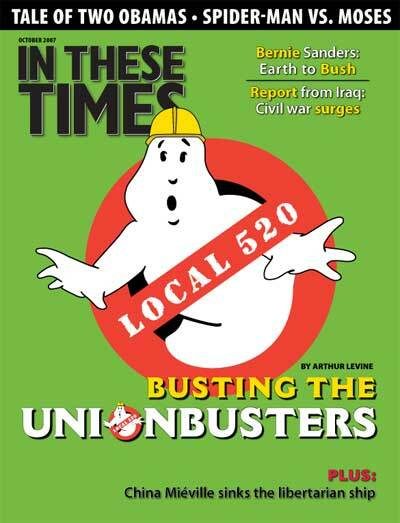Twilight of the Market’s Idols
Not Larry Craig, but George Bush and his careless economic policies, have left the Republican party cornered in a bathroom stall
Susan J. Douglas
As I write this, Republicans, nearly deranged by their own homophobia, have succeeded in ousting Sen. Larry Craig (R-Idaho) because he made some odd foot and hand movements in an airport men’s room. But the person they should be going after, and not just because of the quagmire in Iraq, is Bush, a bigger disaster for the Republican Party than even his colleagues might think. For the Bush administration’s singular accomplishment, aside from demonstrating why unilateral military intervention is a road to ruin, has been to discredit the alleged virtues of free-market ideology.
The neocons’ and Reagan’s crowning achievement in the ’80s was to reverse the 50-year notion, established by the New Deal, that the government had a crucial role in moderating the effects of unchecked capitalism on everyday people. The neocons especially attacked Lyndon Johnson’s Great Society programs as failures. Antipoverty programs, welfare, the school lunch program, prenatal care for poor women and all government regulations hadn’t worked, they claimed, and even made things worse: They promoted a “culture of dependency” that robbed people of the motivation to improve their own lives.
The most effective, fair and wise gyroscope for modulating economic swings and distributing social and economic goods was “the market.” The market optimizes outcomes for all, so the mantra went. The government, by contrast, was inefficient and unfair, giving the greatest benefits to the most undeserving sectors of society. Watching shows like “Wall Street Week” with Louis Rukeyser, one saw and heard the market personified into some all-knowing, beneficent Buddha. The market “liked” certain things (downsizing always made it happy), “responded negatively” to other things, became “jittery” and the like. The market knew best.
By the time Bush and his much-vaunted “CEO presidency” came to roost, the notion that the government had a role to play in shaping public life was unspeakable. Grover Norquist advanced the Bush-Cheney position that if you “kill the taxes, you kill the government.” From the EPA to the FDA to the Veteran’s Administration to FEMA, that is exactly what Team Bush did.
So, what is the track record of “the market”, especially under Bush? How has it done, compared, to say, all those inefficient unfair government programs of yore?
Where to start? Leaving healthcare to the foresight of the market has meant that 47 million Americans – 6 million more than when Bush took office, and nearly 16 percent of the population – do not have health insurance. The sagacity of the market has also meant that more than 600,000 children joined the ranks of the uninsured just since last year.
Having jettisoned LBJ’s “War on Poverty,” the United States now boasts the highest child poverty rate in the developed world: nearly 27 percent. In other countries like France, Sweden and Germany, government programs helped slash their rates to 10 percent or less. (When Johnson launched the “War on Poverty in 1964,” the rate was 19 percent; ten years later it was 11.2 percent. What a failure.)
On the environment, Bush has sought to curb the Environmental Protection Agency (EPA) because the market – in this case, industry – is the superior regulator. There are too many cases here to innumerate, but under Bush, the EPA has weakened pollution laws or postponed their implementation until the next decade, raised the arsenic-in-tap water standards, allowed snowmobiling in national parks, and opened up national forests to the timber industry. The result? Millions of Americans are still exposed to unhealthy air pollution, and 20 million acres of wetlands have been removed from protection under the Clean Water Act.
What happens when we let the market decide which drugs are good and which are bad? Under Bush, FDA enforcement against false and misleading ads declined precipitously as we were bombarded by ever more ads for prescription drugs that sounded official because they had X’s in their names. The FDA’s enforcement of manufacturing standards for producers of vaccines dropped by 80 percent between 2002-2004. The market missed that Vioxx, for example, could kill people, or that other drugs like Celebrex and Bextra might have some problems.
And two years after Katrina, need we say anything about the government’s preparedness for natural disasters?
Everywhere, the safety net – except for the rich – has been shredded under Bush. He’s gone so far that people are rediscovering that we do need strong, well-funded government agencies to prevent us from devolving into a third-world nation. The Democrats may have their work cut out for them in reversing the nearly 30-year-old mantra that the market is the best regulator and the government is the worst, but they have two things on their side: the increasingly widespread, dispiriting experiences of everyday people at the hands of “the market,” and the facts.
Susan J. Douglas is a professor of communications at the University of Michigan and a senior editor at In These Times. She is the author of In Our Prime: How Older Women Are Reinventing the Road Ahead.









